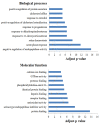Proteomics Analysis Reveals Altered Nutrients in the Whey Proteins of Dairy Cow Milk with Different Thermal Treatments
- PMID: 34361782
- PMCID: PMC8347753
- DOI: 10.3390/molecules26154628
Proteomics Analysis Reveals Altered Nutrients in the Whey Proteins of Dairy Cow Milk with Different Thermal Treatments
Abstract
Thermal treatments of milk induce changes in the properties of milk whey proteins. The aim of this study was to investigate the specific changes related to nutrients in the whey proteins of dairy cow milk after pasteurization at 85 °C for 15 s or ultra-high temperature (UHT) at 135 °C for 15 s. A total of 223 whey proteins were confidently identified and quantified by TMT-based global discovery proteomics in this study. We found that UHT thermal treatment resulted in an increased abundance of 17 proteins, which appeared to show heat insensitivity. In contrast, 15 heat-sensitive proteins were decreased in abundance after UHT thermal treatment. Some of the heat-sensitive proteins were connected with the biological immune functionality, suggesting that UHT thermal treatment results in a partial loss of immune function in the whey proteins of dairy cow milk. The information reported here will considerably expand our knowledge about the degree of heat sensitivity in the whey proteins of dairy cow milk in response to different thermal treatments and offer a knowledge-based reference to aid in choosing dairy products. It is worth noting that the whey proteins (lactoperoxidase and lactoperoxidase) in milk that were significantly decreased by high heat treatment in a previous study (142 °C) showed no significant difference in the present study (135 °C). These results may imply that an appropriately reduced heating intensity of UHT retains the immunoactive proteins to the maximum extent possible.
Keywords: cow milk; heat sensitivity; thermal treatments; whey proteins.
Conflict of interest statement
The authors declare no conflict of interest.
Figures
References
-
- Claeys W.L., Cardoen S., Daube G., De Block J., Dewettinck K., Dierick K., de Zutter L., Huyghebaert A., Imberechts H., Thiange P., et al. Raw or heated cow milk consumption: Review of risks and benefits. Food Control. 2013;31:251–262. doi: 10.1016/j.foodcont.2012.09.035. - DOI
-
- Van Boekel M.A.J.S. Effect of heating on Maillard reactions in milk. Food Chem. 1998;62:403–414. doi: 10.1016/S0308-8146(98)00075-2. - DOI
MeSH terms
Substances
Grants and funding
- ASTIP-IAS12/The Agricultural Science and Technology Innovation Program
- CARS-36/Modern Agro-Industry Technology Research System of the PR China
- CAAS-ZDXT2019004/The Scientific Research Project for Major Achievements of The Agricultural Science and Technology Innovation Program
- R2017YJ-YB3006, R2018PY-QF008/Special fund for scientific innovation strategy- construction of high level Academy of Agriculture Science
- 2020KJ114/Guangdong Modern Agro-industry Technology Research System
LinkOut - more resources
Full Text Sources


